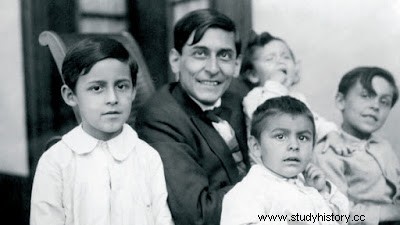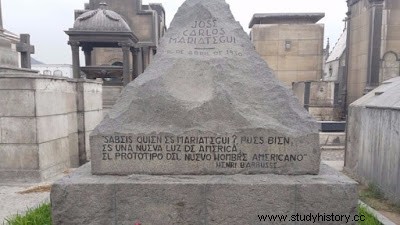
The beginnings. The son of Francisco Javier Mariátegui Requejo and María Amalia La Chira Ballejos, José Carlos Mariátegui was born in a humble home in Moquegua (1894). In 1899, he moved with his family to Huacho, north of Lima, where he suffered an accident that left him with ankylosis that would plague him for the rest of his life. It was this accident that pushed him to focus on reading and studies. At just 15 years old and not finishing school, he began working in the press, eventually training as a journalist.
The thinker of the masses His work in the media led him to write for the mythical Colónida magazine, befriend Abraham Valdelomar, and even write a book of poems, which was never published. His production changed radically in 1918:influenced by Manuel Gonzales Prada, he became interested in social issues such as university reform and workers' struggles, linking up with figures such as César Vallejo, Víctor Raúl Haya de la Torre, Raúl Porras Barrenechea or Luis Alberto Sánchez.
Training in Europe. The government of Augusto B. Leguía granted a scholarship to Europe to José Carlos Mariátegui (1919), as a way to get him out of the country, since he was a harsh critic of the regime. It was in Italy where he completed his socialist education, studying Marxism and languages, interacting with intellectuals of the time and marrying Ana Chiappe. In addition to the transalpine country, he visited nations such as France, Germany or Czechoslovakia, where he nurtured his ideas.
 José Carlos Mariátegui in Italy, where he completed his intellectual training The 7 essays and the Socialist Party. He returned to Peru in 1923 and became an important name in Peruvian politics, especially in the face of Víctor Raúl Haya de la Torre's exile in Mexico (where he would found Apra in 1924). After suffering the amputation of his leg (1924), he founded the Editorial Minerva (1925) and the Amauta Magazine (1926), which brought together intellectuals of the time and germinated the indigenist current in art and literature. In 1927, he published his fundamental work:7 essays on the interpretation of Peruvian reality, where he analyzes the processes of the Peruvian economy, history, and literature. In 1928 he broke with Haya de la Torre and founded the Peruvian Socialist Party and in 1929, the General Confederation of Workers (CGTP), in force until today.
José Carlos Mariátegui in Italy, where he completed his intellectual training The 7 essays and the Socialist Party. He returned to Peru in 1923 and became an important name in Peruvian politics, especially in the face of Víctor Raúl Haya de la Torre's exile in Mexico (where he would found Apra in 1924). After suffering the amputation of his leg (1924), he founded the Editorial Minerva (1925) and the Amauta Magazine (1926), which brought together intellectuals of the time and germinated the indigenist current in art and literature. In 1927, he published his fundamental work:7 essays on the interpretation of Peruvian reality, where he analyzes the processes of the Peruvian economy, history, and literature. In 1928 he broke with Haya de la Torre and founded the Peruvian Socialist Party and in 1929, the General Confederation of Workers (CGTP), in force until today. José Carlos Mariátegui with his children, in the months before his death
José Carlos Mariátegui with his children, in the months before his death  José Carlos Mariátegui, already with his leg amputated, in the Parque de la Reserva An early death. The success of his work led him to be invited in 1929 to the Communist Conference of Latin America in Montevideo. Due to the state of his health, he could only send some emissaries with his approach. There he distanced himself from the rest of the parties of this type on the continent, due to ideological differences. "Neither trace nor copy," wrote Mariátegui about his model for Peru, in which he did not seek to imitate other countries but to forge his own path. On April 16, 1930, shortly before traveling to Argentina to undergo surgery for his illness, he died in the hospital and was buried in the Presbítero Maestro, like several presidents and heroes of Peru. Just over a month later, the Socialist Party changed its name to the Communist Party.
José Carlos Mariátegui, already with his leg amputated, in the Parque de la Reserva An early death. The success of his work led him to be invited in 1929 to the Communist Conference of Latin America in Montevideo. Due to the state of his health, he could only send some emissaries with his approach. There he distanced himself from the rest of the parties of this type on the continent, due to ideological differences. "Neither trace nor copy," wrote Mariátegui about his model for Peru, in which he did not seek to imitate other countries but to forge his own path. On April 16, 1930, shortly before traveling to Argentina to undergo surgery for his illness, he died in the hospital and was buried in the Presbítero Maestro, like several presidents and heroes of Peru. Just over a month later, the Socialist Party changed its name to the Communist Party. The tomb of José Carlos Mariátegui in the Presbítero Maestro. In addition to the praise in his epitaph, he has been described as "the greatest Marxist philosopher of Latin America "
The tomb of José Carlos Mariátegui in the Presbítero Maestro. In addition to the praise in his epitaph, he has been described as "the greatest Marxist philosopher of Latin America "SOURCE:http://rpp.pe/peru/historia/quien-fue-jose-carlos-mariategui-y-por-que-se-remember-noticia-971087
